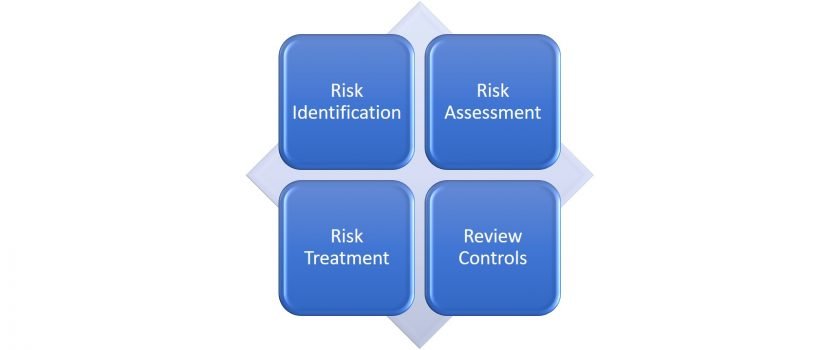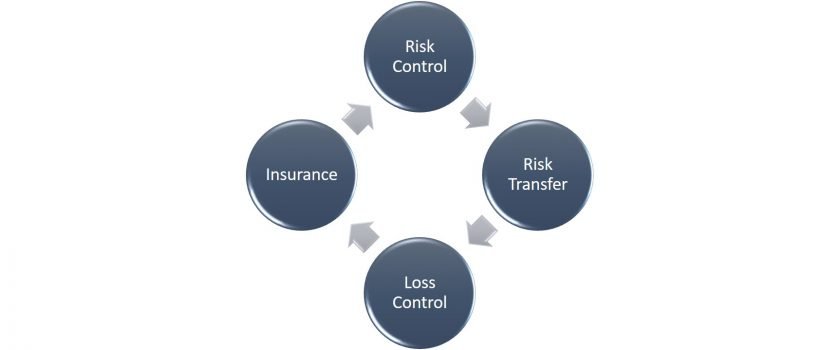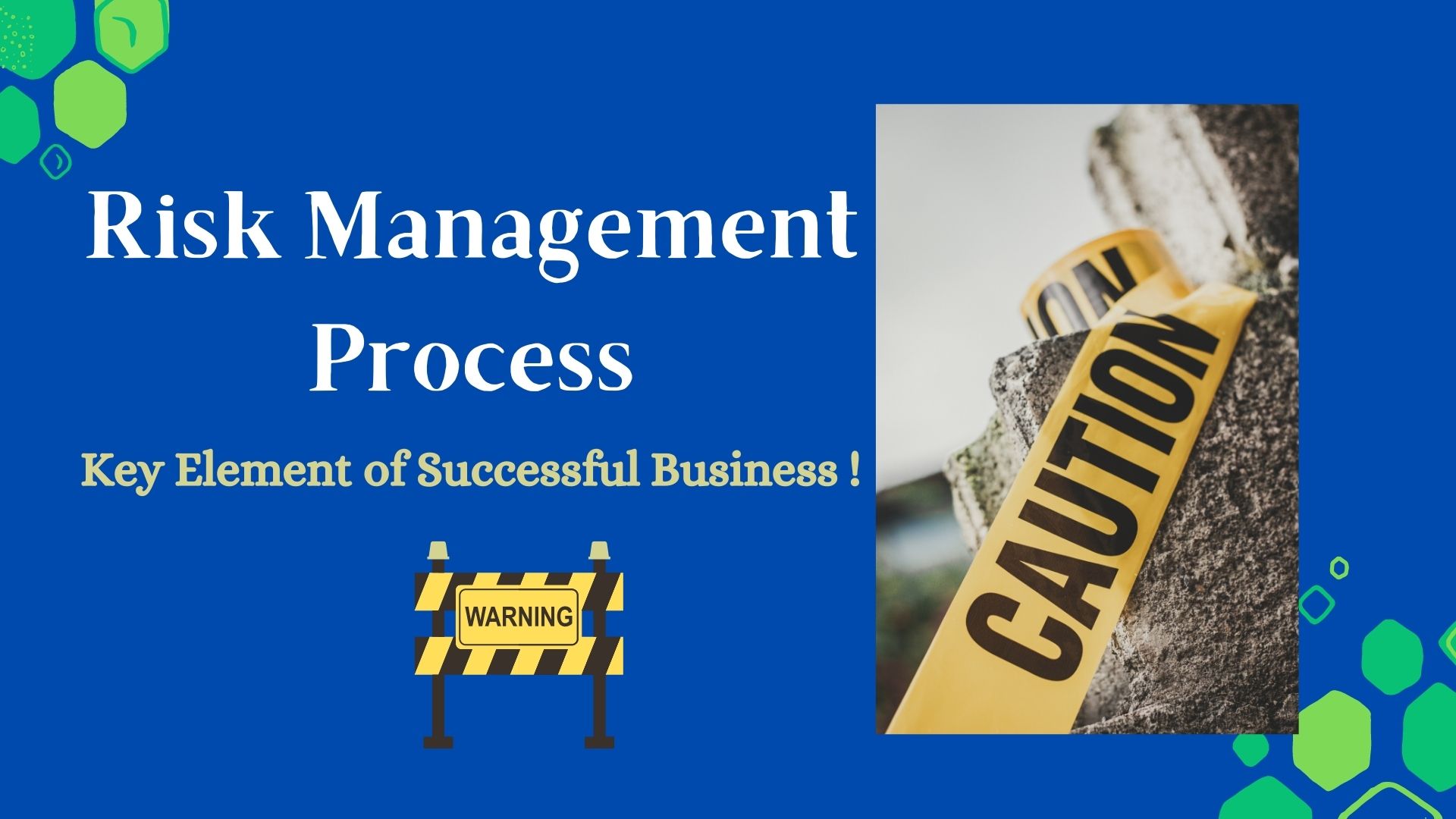Risk is the key ingredient that determines your success or failure. Risk takes you out of your comfort zone to achieve a pre-determined goal but there is no guaranteed outcome, it may change your life from rags to riches or from riches back to rags. In reality, your life carries risk at every point. Be it the risk of your life, financial risk, or job risk. Risk is part and parcel of your everyday life. As risk is inevitable what you need to learn is how to manage risk. The risk management process is what will help you to take calculated risks while ensuring the mitigation of risks at all levels. Be it Individual risk or enterprise risk, the risk management process can help you to minimize risk while giving you the freedom to achieve your desired goals.
You need to take risks to take the road to success. On the contrary, your journey may end up in failure. This does not mean that you should stop taking risks. As all successful people were able to taste the flavor of success only because they took risks and knew how to manage them. The risk management process comes as a relief to all who are risk-takers and gives them the power to mitigate it at the same time.
Table of Contents
What is Risk?
A risk is an uncertain event that may have a positive or negative outcome. It is the possibility of favorable or adverse results flowing from any occurrence.
Example – financial risk, life risk, theft risk, etc.
What are the different types of risks?
There are different types of risks based on below: –
Based on the consequence of the event
- Speculative risk – It is the risk that involves speculation or anticipation which results in either profit or loss. Trading in shares is considered a speculative risk, where you invest money on shares of a company with anticipation of profit due to various factors considered. This transaction might result in profit or loss.
- Pure risk – It is linked with uncertain events resulting in loss or no loss. Sudden Flood or fire may cause huge damage but no occurrence of such events does not result in profit.
Based on the nature of the event
- Fundamental risk – It affects a large number of individuals within a community or affects the entire economy due to underlying risks beyond the control of individuals like inflation.
- Particular risk – It affects a particular individual caused by individual events like theft in one’s house.
Based on the nature of the environment
- Static risk – It occurs due to unnatural and uncertain events like earthquakes, fire. The occurrence is regular and relatively predictable.
- Dynamic risk – It occurs due to rapidly changing environments like unemployment or war. Mostly arises due to changes in the economy and cannot be predicted.
What is Risk Management Process?
Risk management is the process by which various risk exposures are identified, measured, and controlled. It is the systematic application of principles, approach, and process to the tasks of identifying and assessing the risk and planning the responses. The risk management process is the process whereby the risk with the greatest loss and greatest probability of occurrence is handled first and the risk with low probability is handled in descending order. There are various techniques to manage risk.
Objectives of Risk Management Process
- Increase the probability of a positive or favorable event
- Reduce the occurrence of negative or adverse event
- It encourages to analyze of different types of predictable risks
- Helps to formulate solutions to mitigate anticipated risks
- Ensure effective utilization of resources and cost optimization
- Minimize cost of human errors
- Alignment with corporate strategies and achievement of desired goals within defined timelines
- Helps to prioritize corporate objectives and safeguard the interests of the stakeholders by mitigating risks
- Encourage consistent corporate performance with higher profitability
Steps for Risk Management Process
- Risk Identification
- Risk Assessment
- Risk Treatment
- Review Controls or monitor risk management plan

Risk Identification
Determine the source of various types of potential risks that might impact the business. The risk source could be either internal or external to the system. Below are common methods of risk identification
- Taxonomy-based Risk Identification– Preparing a questionnaire that asks questions whose answers determine the list of potential risks. This helps in breaking down the possible sources of risks.
- Objective-based Risk Identification– A corporate has pre-determined objectives and any obstacle that comes in the way of achieving those objectives are defined as risk.
- Scenario-based Risk Identification – Various scenarios are listed, all those undesirable scenarios that create hindrance in the way of achieving goals are listed as risks.
- Common Risk Check – Various risks are associated with a particular industry or sector. All those risks are listed out.
Risk Assessment
Risk assessment involves risk analysis and risk evaluation.
- Risk Analysis – Once the potential risks are identified, the next task is to assess the probability of occurrence and consequence of each risk. The nature of each risk is to be studied in detail to know how adverse would be its impact or outcome.
- Risk Evaluation – The risk analysis is done, now each risk needs to be ranked based on its probability of occurrence and magnitude of impact. The more adverse the impact of risk is the higher should be its priority to treat or prepare a risk management strategy to deal with it on priority.
Risk Treatment
Once the risks are ranked based on the magnitude, those needs to be treated on priority are determined. Thus, in this stage risk management plans and strategies are formulated to mitigate the priority ranked risk recurrence and reduce adverse impacts. Preventive plans and contingency plans are also created in this stage. Thus, this is where the innovative plans are formulated to mitigate risks at all levels without impacting the normal day-to-day business.
Risk Control
Once the risk management framework is laid down, the risk mitigation plan is reviewed and monitored to ensure that the formulated strategies are working effectively to mitigate risks at all levels. This process helps in identifying those strategies which were effective to reduce specific types of identified risks, thus those strategies will be retained. Those which were not effective to mitigate specific identified risks will be avoided in the future. Thus, an effective risk management process is set up with pre-determined strategies to mitigate all identified risks and increase productivity.
Thus, the risk management process helps to resolve problems when they occur, because those problems have already been envisaged, and plans to treat them have already been developed and agreed upon.
Enterprise Risk Management Process (ERM)
It is the process of planning, organizing, leading, and controlling the activities of an organization in order to mitigate risks at all levels. It is an ongoing process that helps in identifying potential risks and treating those risks effectively with risk management plans.
There are 8 components of the Enterprise Risk management process
- Internal environment
- Objective setting
- Event identification
- Risk assessment
- Risk response
- Control activities
- Information and communication
- Monitoring
Types of risks in Enterprise Risk Management Process (ERM)
- Credit Risk – It is the risk arising out of debt in the form of loans from banks, from other financial institutions, or other sources. The fixed and variable obligations might squeeze the firm’s ability to generate consistent profits.
- Market risk – It is the risk associated with uncertainties in the market due to demand and supply. Seasonality also impacts the demand or supply of products and services.
- Operational risk – Risks associated with day-to-day operational activities of a company. Like IT failure or data breaches may impact a firm’s daily operational effectiveness.
- Strategic risk – These are external sources of risk that have the ability to affect the strategic decisions of any company. It may impact its course of action in the long run.
- Compliance risk – Relates to various rules, regulations, and procedures to be followed as advised by the legislation or government. Non-adherence to these may result in penalties and disruptions. Risk arising from changing legislative regulations may impact a business adversely.
- Financial risk – It refers to the risks associated with financial decisions and costs. Changes in the economy will have a financial impact on the business, thus increasing the risk of high cost, high finance charges.

Advantages of Risk Management Process
There are various advantages of the risk management process to any organization. Some are listed below:
- It helps in identifying various possible risks or threats to deal with.
- It helps the business to estimate what amount of contingency funds should be maintained to deal with any forecasted risks or threats.
- Risk management plans and strategies can be formulated to determine how to mitigate all the possible risks identified.
Helps to automate the risk management process by retaining those plans which have worked successfully to mitigate risks and avoid those plans which did not work out.
Challenges of the Risk Management Process
There are some challenges called out below.
- The cost of recruiting people with expertise in risk mitigation is high.
- The training cost is also involved to prepare the employees for unforeseen circumstances.
- The research and development team is also involved to help devise new innovative ways to mitigate risks and improve profits.
Risk Management Tools or Methods
There are some risk management tools that may be used for risk mitigation and management purpose.
- Risk Control– To control risk, below two methods may be applicable:
- The risk avoidance method is where the root cause from which the risk is triggered is ripped off. It means eliminating risk by nipping it in the bud. Example – avoid the risk of divorce by not getting married or avoid car accident risk by not driving a car.
- Risk reduction is used when risk is already triggered and thus the best way is to minimize its impact or mitigate its effects. Example – minimize theft risk by installing a security system for home or minimize the risk of fire by installing fire extinguisher.
- Risk Transfer – To manage risk, the risk transfer method is widely used. It involves below two methods:
- Contract – When a transaction takes place between the buyer and the seller, where the buyer may transfer the risk arising out of a defective or damaged product or service by purchasing the warranty and guarantee clause.
- Hedging – In this, the price or the rate is fixed between the parties on the signing date of the agreement and remains fixed for the future date. In this way, the seller gets a guaranteed amount irrespective of the market fluctuation and the buyer is able to buy at a fixed price.
- Loss Control – It is loss prevention or reduction method which helps in reducing the probability of occurrence of loss arising out of predictable uncertainties. It involves studying the factors arising out of losses and then minimizing those factor effects. Example – The risk of death arising from driving after getting drunk. Thus, not driving after drinking will help eliminate this risk.
- Insurance – It is the most commonly used method used by people or businesses to transfer the risk to Insurance companies in exchange for a specified amount charged by the Insurance company called the premium. The one who pays the premium is called insured and the insurance company is called Insurer. An insurance company would be able to pay the loss because it pools the premium collected from many people and invests the same to pay the few who incur significant losses.

FunFact
Due to the pandemic, the IT risk management teams in the corporates are more focused on dealing with cybersecurity risks due to remote working. Remote working has led to increased demand for virtual learning and training sessions thus exposing to security risks.
Let us know your thoughts on the risk management process?


